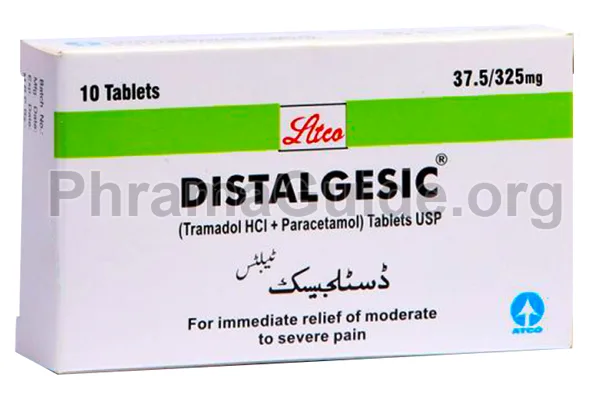Distalgesic tablet provides strong analgesic effects and is used for the management of acute or chronic painful conditions. Following are some common uses of Distalgesic Tablets:
- Pain and Inflammations (Acute or Chronic)
- Arthritis Pain
- Fever
- Dental Pain
- Dysmenorrhoea
Off-label Uses of Distalgesic Tablet
- Fibromyalgia
- Postoperative Pain
- Chronic Back Pain
- Neuropathic Pain
- Cancer Pain
- Migraine
- Postpartum Pain

What is Distalgesic?
Distalgesic is generically known as Tramadol + Paracetamol and it is manufactured and marketed by Atco Laboratories, Pakistan.
Distalgesic Alternatives : Other Similar Brands
The following are some available alternative brands of Distalgesic and their manufacturers.
- Tramal Plus : Searl Pakistan (Pvt) Ltd.
- Tonoflex P : Sami Pharmaceuticals (Pvt) Ltd, Pakistan.
- Pantra Plus : Getz Pharmaceuticals (Pvt) Ltd, Pakistan.
- Taxidol : Continental Pharmaceuticals (Pvt) Ltd, Pakistan.
- Tramapar : Efroze Pharmaceuticals (Pvt) Ltd, Pakistan.
- Dol P : Genix Pharmaceuticals (Pvt) Ltd, Pakistan.
- Activol : Don Valley Pharma (Pvt) Ltd, Pakistan.
- Trampol : Genetic Pharmaceuticals (Pvt) Ltd, Pakistan.
- Krotam : Martin Dow Pharmaceuticals (Pvt) Ltd, Pakistan.
- Tracetol : Apsin Pharmaceuticals (Pvt) Ltd, Pakistan.
Distalgesic : Available Formulations and Strengths
Presently, Distalgesic is available in Tablet Form.
Distalgesic Tablet : Tramadol 37.5mg and Paracetammol 325mg strengths
Who Should Not Use Distalgesic?
Distalgesic should not be taken by individuals with certain medical conditions such as respiratory depression, asthma, renal impairment, seizure disorders, head injuries, or any condition where opioids should not be used due to the potential for adverse effects.
People who have a history of drug abuse or addiction should avoid using this medication as it can lead to dependence on the drug. Those taking certain medications such as MAO inhibitors should not take this medication without first consulting their doctor. The interactions between these medications could cause serious side effects if combined without proper guidance from a healthcare professional.
Before beginning treatment with Distalgesic it is important that you discuss your full medical history with your doctor including any current medications you are taking or have recently taken in order to ensure safe use of this medication.
Additionally, pregnant women need to consult their physician before taking Distalgesic since safety in pregnancy has not been established yet. Furthermore, breastfeeding mothers should also avoid using Distalgesic since it passes into breast milk. It could potentially harm an infant’s health if consumed through breastfeeding milk supply directly or indirectly through the mother’s milk ingestion by the baby during the lactation period.
What is the Recommended Daily Dosage of Distalgesic?
Distalgesic is a prescription medication. So, it is recommended to take its dose as the doctor determined.
For Aduts: The usual dose is 1-2 tablets of Distalgesic and can repeat after 6 hours if necessary.
However, the dose should not exceed 8 tablets of Distalgesic in a day.
For Children: Distalgesic is not recommended for children under the age of 12 years.
How Distalgesic Works?
Distalgesic generic name is Pracetamol+Tramadol and it works in two ways.
Tramadol targets opioid receptors in the brain. It works by blocking the pain signals traveling through the nerves.
Paracetamol provides an analgesic effect by inhibiting the release of prostaglandins which are pain and inflammation mediators in the body.

Leave A Comment